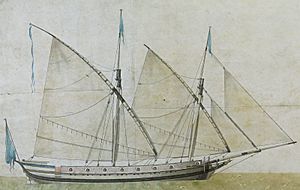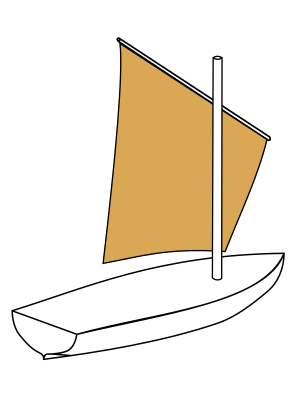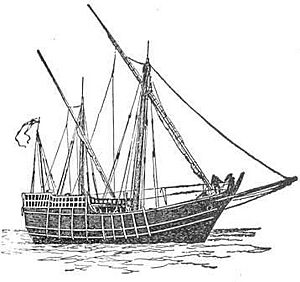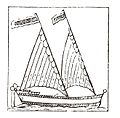Lateen facts for kids
A lateen sail is a special type of triangular sail. It's attached to a long pole called a yard. This yard is set at an angle on the boat's mast. It helps the boat move forward, even when the wind isn't blowing directly from behind.
This sail has been used since Roman times. It became very popular during the Age of Discovery. This was because it allowed ships to sail "against the wind" by tacking. You can still see lateen sails on boats in the Mediterranean, the Nile River, and parts of the Indian Ocean. They are common on feluccas and dhows. Smaller boats like the Sailfish and Sunfish also use a similar design.

Contents
How Lateen Sails Work
A simple square sail just catches the wind from behind and pushes a boat forward. The lateen sail is more clever. It is set at an angle to the wind. This creates different air pressures on each side of the sail. One side has higher pressure, and the other has lower pressure. This difference pulls the boat forward.
This is similar to how a fore-and-aft sail works. That's why the lateen sail is seen as an early version of the fore-and-aft sail. Lateen sails are good in lighter winds. They create less drag, which means they are more efficient. They also let a boat sail much "closer to the wind." This means a boat can sail at an angle of about 45 degrees into the wind. This ability made the lateen sail a very important invention for sailors.
How the Lateen Sail Developed
The lateen sail didn't just appear from the square sail. There was an in-between type of sail called the lug sail. This was one of the first fore-and-aft rigs. It was developed in the Indian Ocean. Sailors knew that the wind doesn't always blow from behind the boat. They found that a square sail could work better if it was turned on the mast. This kept it at a right angle to the wind.
When used with a keel (a fin on the bottom of the boat) and a way to steer, this gave sailors more choices. Instead of only sailing downwind, the boat could move in different directions. If the wind came from the side of the ship, turning the sail became less helpful. But, if the luff (the front edge of the sail) pointed into the wind and stayed tight, the sail would pull the boat forward. This worked even better if the yard holding the sail sloped down into the wind. From this idea came the lug sail, and then the lateen sail.
History of Lateen Sails
In ancient history, square sails were common in the Mediterranean Sea. They were used on ships by the Phoenicians, Egyptians, Greeks, and Romans. In Northern Europe at this time, only square sails were used. This was true even after ships in the Mediterranean started using the triangular lateen sails.
The 15th and 16th century caravel was a popular ship. It was used by Portuguese and Spanish explorers during the voyages of discovery. These ships had a special single sterncastle (a raised part at the back of the ship). They also carried lateen sails. During this time, the caravel became a very fast and easy-to-steer ship.
Two of Christopher Columbus's ships, the Niña and the Pinta, were caravels. Columbus often said the Niña was his fastest and favorite ship.
Images for kids
-
Byzantine ship rigged with settee sail (miniature from c. 880)
-
Dhow with lateen sail in "bad tack" with the sail pressing against the mast, in Mozambique.
-
A large dhow with two settee sail rigs and a headsail.
-
Lateen-rigged caravel, the main vessel of the Portuguese long-distance explorations.
-
1846 illustration of a Fijian camakau, a single-outrigger canoe with a crab claw sail.
See also
 In Spanish: Vela latina para niños
In Spanish: Vela latina para niños









